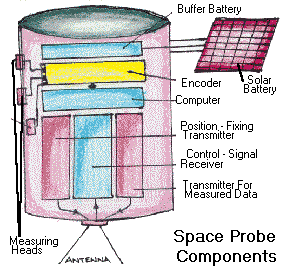Construction of Satellites
Diana S. / Physics 337 / April 17,1997

There are several factors that bring about the construction of a satellite.
The structure, design, and cost are important characteristics of a satellite.
Each one has different qualities which make up a satellite.
Structure:
The structure is important in the construction of a satellite. The
structure must be 15-25 per cent of the total spacecraft weight which is
considered light. The structure must also, "avoid resonances which
would amplify by a factor exceeding 4 to 6 the vibration communicated by
the rocket" (Fishlock 15).
Spacecraft structures fall into 2 large categories. The one most often
used consists of a rigid core. This rigid core is like a stiff torsion
tube carrying all loads transmitted by plateau, which is what equipment
is attached too, with outriggers to support the other structural elements
such as solar panels. "In the alternative, a box structure, most of
the loads are carried by the outer surfaces" (Fishlock 15). It is
used when a lot of pressurized volumes are needed, such as for a manned
flight. Second, thermal control which is to keep with in suitable limits
the temperature of solar radiation and by internal power dissipation. Third,
power supply. In almost every Earth satellite, silicon solar cells are
used to change solar into electrical energy. Fourthly, attitude control
which is to keep the satellite in the necessary attitude with respect to
the Earth and the Sun. Fifth, satellite in the required direction, and
the attitude must be known. The last is station-keeping for which, "a
sub-system is required only when it is necessary to control closely the
position of the satellite as with the geostationary satellites" (Fishlock
16).
Design:
Satellites are usually made to meet the mission requirements of specific
application. Their design is primarily influenced by the combination of
the performance and characteristics of the launch vehicle, the characteristics
of the useful equipment or payload, and the geometry of the selected orbit.
The design of a Global positioning system satellite has three segments,
a space segment, control segment, and a user segment. The space segment
has 24 Navstar satellites (2 active and 3 spare) orbiting the Earth. They
serve as the radio beacons that users sight to determine their own positions
and velocities. The control segment has 5 monitoring stations and 1 master
control station. They provide updated error corrections to keep the systems
accurate and they also monitor the system. The user segment has a radio
receiver coupled with a signal-processing computer that finds its own location
by searching for more of the GPS satellites.
Cost:
The cost of a satellite shows the value and expense in the construction
of a satellite. In 1971 the average overall costs for launching, developing,
maintaining, and operating a single application satellite in orbit over
a period of 5-10 years usually exceeds 10 million a year, and often reaches
several times this figure.
The manufacturing and development costs in industry of Earth satellites
are proportional to their weight. "With the coefficient of proportionality
lying between $100,000 and $160,000 per kg., depending upon various factors"
(Fishlock 21). These factors are past experience of contractors which is
often all sub-systems already developed that can readily be adapted. The
design complexity, "spinning satellites with body mounted solar cells
can be expected to be near the lower value, and 3-axis stabilized satellites
near the higher" (Fishlock 21). Payload complexity, "costs increase
rapidly with the complexity of payload instrumentation" (Fishlock
21). Even when this does not influence the simplest design of a satellite.
Project duration is when fast developments are likely to cost much less
than long ones but they are also connected with higher risks of delays.
The last factor is overall weight which is a second order of tendency that
exists, "nevertheless, towards a decrease in specific costs per kg.
with increasing spacecraft weight, because several sub-systems are little
affected by satellite size" (Fishlock 21).
MCI came away the winner of a Federal Communications Commission Auction.
Also the worth of a global sensory organ has a cost of operating. It can
cost up to more than 50 billion.
Conclusion:
The structure, design, and cost all play important roles in the construction
of a satellite. The structure consists of a light one and there are several
factors that make up the spacecraft, such as thermal control, power supply,
attitude control, attitude reference, and station-keeping. In a satellites
design there are three segments which are, control segment, space segment,
and user segment. There are also three influences in a design, characteristics
of useful equipment, geometry, and performances of launch vehicle. The
cost can also exceed 10 million a year. The cost is also proportional to
their weight. It is between $100,000 and $160,000 per kg. and it depends
on several factors, such as past experience of contractors, design complexity,
payload complexity, project duration, and overall weight. The different
characteristics of structure, design, and cost all serve important roles
in the construction of a satellite.
References
DeLoughry, Thomas J. "Support Weakens for Satellite to Aid Education."
Chronicle of Higher Education. 3 May 1996: A31.
Fishlock, David. A Guide to Earth Satellites. New York: Macdonald:
London and American
Elsevier Inc., 1971.
Lane, Earl. "Power Play/Shuttle to Deplay 12 Mik Cord to Make
Electricity." 24 Feb. 1996
A06. Newsday. CD-Rom Newsbank, Inc. 1996.
McCormac, John. "Satellite Signal Piracy The European Experience."
Electronics Now August
1995: 37-40, 70.
Oberright, John E. "Satellite, Artificial." The World
Book Encyclopedia. 1996 ed.